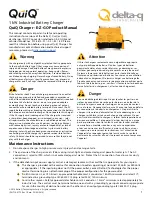
Battery Charger RLD
User's Manual
BURN AND BODILY INJURY PREVENTION
The battery produces very high currents when short circuited, and will burn the skin severely if
in contact with any metal conductor that is carrying this current.
Do not permit rings on fingers to come in contact with battery terminals or the cell connectors
on top of the battery.
Battery acid is very corrosive. Alwais wear correct eye and body protection when near batteries.
FIRE AND EXPLOSION PREVENTION
When batteries are being recharged, they generate hydrogen gas that is explosive in certain
concentrations in air (the flammability or explosive limits are 4.1% to 72% hydrogen in air). The
spark-retarding vents help slow the rate of release of hydrogen, but the escaping hydrogen may
form an explosive atmosphere around the battery if ventilation is poor.
The ventilation system should be designed to provide an adequate amount of fresh air for the
number of batteries being charged. This is essential to prevent an explosion.
Always keep sparks, flames, burning cigarettes, and other sources of ignition away from the
battery recharging area. Do not break "live" circuits at the terminals of batteries. Do not lay tools
or anything that is metallic on top of any battery.
To prevent arcing and burning of the connector contacts, be sure the charger is OFF before
connecting or disconnecting the battery. The digital display must be completely OFF.
MEDICAL AND FIRST AID TREATMENT
First aid facilities and a qualified first aid person should be available for each shift for immediate
treatment of electrical shock victims.
EMERGENCY FIRST AID: Call phisician and ambulance immediately and use First Aid techniques
recommended by the American Red Cross.
In case of acid in the eyes, flush very well with clean water and obtain professional medical
attention immediately.
EQUIPMENT WARNING LABELS
Inspect all precautionary labels on the equipment.
Order and replace all labels that cannot be easily read.
OWM-AR-D-[]
Page 6 of 23
DANGER: ELECTRICAL SHOCK CAN BE FATAL.
If person is unconscious and electric shock is suspected, do not touch person if he or she is in
contact with charging equipment, battery, charging leads, or other live electrical parts.
Disconnect power at wall switch and then use First Aid.
Dry wood, wooden broom, and other insulating material can be used to move cables, if
necessary, away from person.
IF BREATHING IS DIFFICULT, give oxygen.
IF NOT BREATHING, BEGIN ARTIFICIAL BREATHING, such as mouth-to-mouth.
IF PULSE IS ABSENT, BEGIN ARTIFICIAL CIRCULATION, such as external heart massage.







































